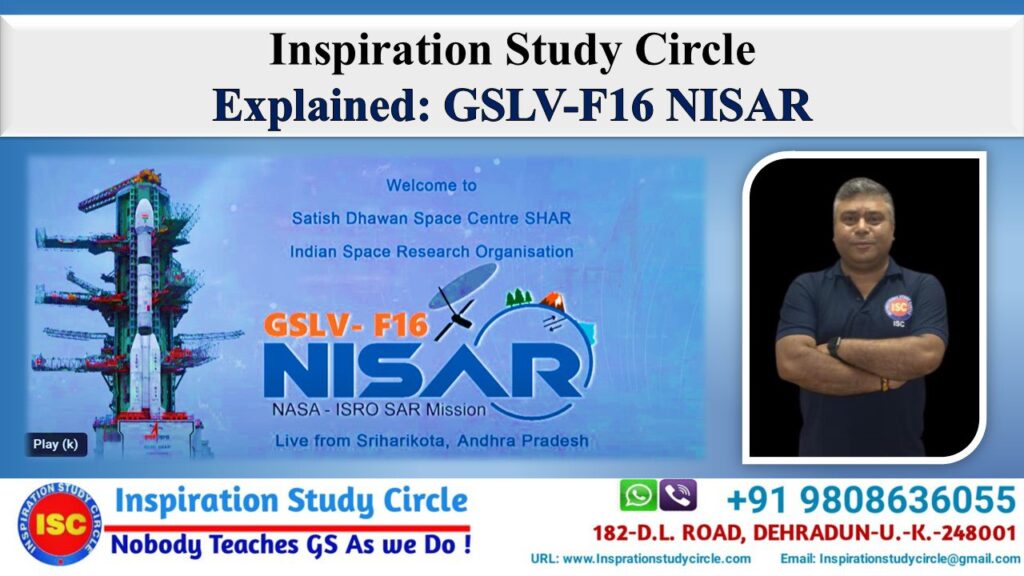
The Viksit Bharat – Guarantee for Rozgar and Ajeevika Mission (Gramin) Bill, 2025
The Viksit Bharat – Guarantee for Rozgar and Ajeevika Mission (Gramin) Bill, 2025 Table of Contents The Viksit Bharat – Guarantee

The NISAR (NASA-ISRO Synthetic Aperture Radar) mission is a joint project between the space agencies of the United States (NASA) and India (ISRO). The mission uses advanced radar technology to measure Earth’s changing surfaces, ecosystems, ice masses, and more, according to ISRO.
Spacecraft Configuration
The Major Mission Configuration and Joint Work Share responsibilities are detailed below:
Major Mission Characteristics (Joint Mission of ISRO & NASA) | |
Mainframe Bus | I3K Structure with ~2400Kg Lift Off Mass |
Imaging Payload | · Dual Frequency (L & S-Band) Synthetic Aperture Radar (SAR). · L-band SAR (NASA); S-band SAR (SAC-ISRO) · Large size 12m diameter common unfurlable reflector antenna mounted on deployable 9m Boom. · ~240 km observable swath with 5-100 m resolution Free and open data policy |
Orbit | Sun synchronous, Polar (6 PM) |
Orbit altitude | 747 km – Circular |
Inclination | 98.405 deg |
Launcher | GSLV Mk-II with 4m PLF |
Mission Life | 5 Years |
NISAR is the first of its kind mission, jointly developed by ISRO and NASA. It is an L and S-band, global, microwave imaging mission, with the capability to acquire fully polarimetric and interferometric data.
The unique dual-band Synthetic Aperture Radar of NISAR employs an advanced, novel SweepSAR technique, which provides high-resolution and large-swath imagery. NISAR will image the global land and ice-covered surfaces, including islands, sea ice, and selected oceans, every 12 days.
NISAR mission’s primary objectives are to study land & ice deformation, land ecosystems, and oceanic regions in areas of common interest to the US and Indian science communities.
The NISAR mission will help to:
In essence, the NISAR mission, carried aloft by the GSLV-F16, marks a significant leap forward in Earth observation and international space cooperation, providing unprecedented insights into our planet’s dynamic processes and helping address critical global challenges related to climate change, natural hazards, and resource management.
The complex payloads and mainframe systems have been designed, developed, qualified, and realised over 8 to 10 years.
The S-Band SAR and L-Band SAR were independently developed, integrated, and tested at ISRO and JPL/NASA, respectively.
The Integrated Radar Instrument Structure (IRIS), consisting of S–Band and L–Band SAR and other payload elements, was integrated and tested at JPL/NASA and delivered to ISRO.
Mainframe satellite elements and payloads were assembled, integrated, and tested at URSC/ISRO.
NISAR mission phases can be broadly classified into: Launch phase, Deployment Phase, Commissioning Phase, and Science Phase.
NISAR will be launched onboard GSLV-F16 launch vehicle on July 30, 2025, from ISRO’s Satish Dhawan Space Centre (SDSC), also referred to as Sriharikota High Altitude Range (SHAR), located in Sriharikota on the southeast coast of the Indian peninsula
NISAR hosts a 12m diameter large reflector, which shall be deployed in orbit 9m away from the satellite by a complex multistage deployable boom designed and developed by JPL/NASA.
The first 90 days after launch will be dedicated to commissioning, or In-Orbit Checkout (IOC), the objective of which is to prepare the observatory for science operations. Commissioning is divided into sub-phases of initial checks and calibrations of mainframe elements, followed by JPL engineering payload and instrument checkout.
The science operations phase begins at the end of commissioning and extends till the end of mission life. During this phase, the science orbit will be maintained via regular maneuvers, scheduled to avoid or minimize conflicts with science observations. Extensive calibration and validation (CalVal) activities will take place. The observation plan for both L and S-band instruments, along with engineering activities (e.g., maneuvers, parameter updates, etc.), will be generated pre-launch via frequent coordination between JPL and ISRO
NISAR marks a striking shift in how we approach critical sectors such as aviation safety, maritime navigation, coastal management, and urban infrastructure planning.
Launched aboard GSLV-F16, this was the first time ISRO’s GSLV vehicle successfully placed a satellite into a Sun-synchronous Polar Orbit. This 18th flight of the GSLV—and the 12th using the indigenous cryogenic stage—demonstrates India’s growing technological maturity in space systems.
Jointly developed by NASA and ISRO, the NASA-ISRO Synthetic Aperture Radar (NISAR) is the world’s first Earth observation satellite to carry dual-frequency synthetic aperture radars—L-band by NASA and S-band by ISRO—on a single platform. It will deliver high-resolution, all-weather, day-and-night imagery of Earth’s land and ice surfaces, revisiting each location every 12 days.
While NISAR’s applications in disaster management, climate monitoring, glacier tracking, and agriculture are well documented, the satellite’s impact will extend far beyond.
The 2,393-kg satellite was inserted into a 747-kilometre Sun-synchronous orbit. Over its five-year mission life, NISAR will offer invaluable data for global climate science, seismic and volcanic monitoring, forest mapping, and resource management.
The open-access policy for NISAR’s data will empower not only scientists and researchers but also developing countries, disaster-response agencies, and climate change stakeholders worldwide.
Under the visionary leadership of Prime Minister Narendra Modi, India’s space programme is evolving from utility-based missions to knowledge-based initiatives. From Chandrayaan to NISAR, we are not only launching satellites—we are launching new possibilities for global science, sustainability, and shared progress.
Disclaimer: The above information and statistics are sourced from the official website of ISRO and Press Bureau Information on NISAR.
You may also like

The Viksit Bharat – Guarantee for Rozgar and Ajeevika Mission (Gramin) Bill, 2025 Table of Contents The Viksit Bharat – Guarantee

How to Prepare for UKPCS 2026 in Six Months Table of Contents ISC- How to Prepare for UKPCS 2026 in

UKPSC Upper and Lower PCS Combined Batch for 2026-2027 Table of Contents Unlocking Uttarakhand’s Civil Services: The Power of UKPCS

Explained: Russian President Vladimir Putin’s State Visit to India Table of Contents Russian President Vladimir Putin conducted a state visit

UPPSC Upper PCS 2025: Mains Test Series and Answer Writing Table of Contents Inspiration Study Circle- Dehradun The UPPSC PCS

The Sanchar Saathi App Table of Contents The Sanchar Saathi app is a security and user-protection platform developed by India’s Department of Telecommunications (DoT) to help users manage mobile connections, report fraud, and locate lost phones